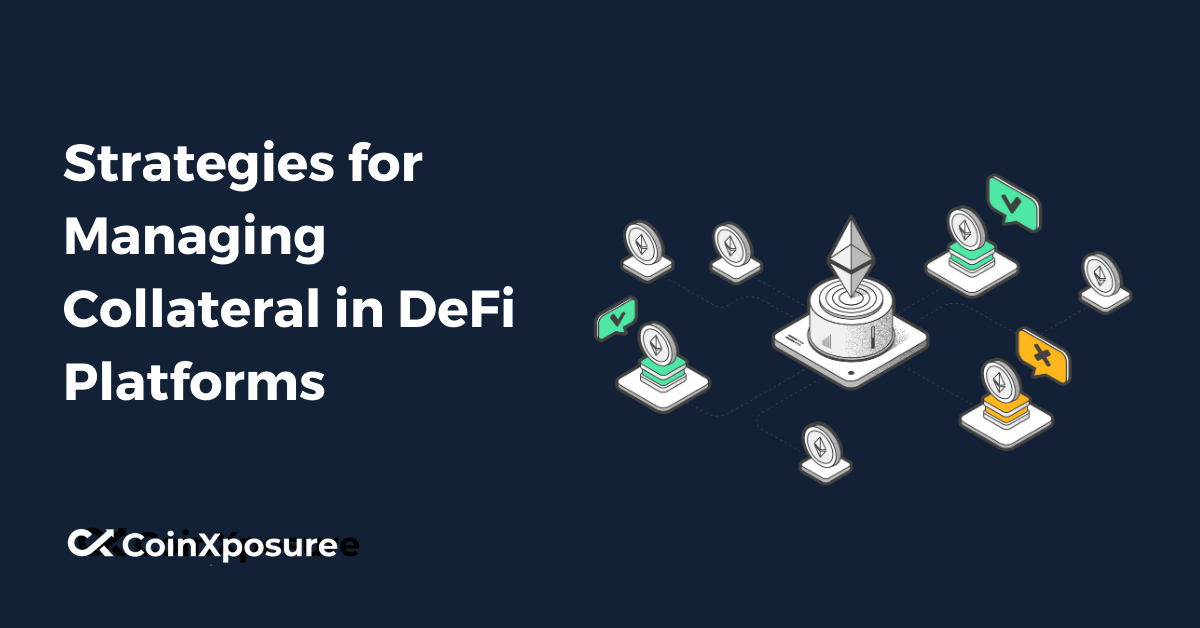Decentralized Finance (DeFi) has revolutionized the traditional financial landscape by offering open, permissionless, and trustless access to financial services.
At the heart of many DeFi platforms lies the concept of collateral, which serves as a cornerstone for securing loans, enabling liquidity provision, and facilitating various financial activities.
Effective collateral management is crucial for maintaining the stability and security of these platforms.
In this context, this discussion delves into the strategies employed for managing collateral within DeFi ecosystems, aiming to explore methods for optimizing risk management, ensuring asset security, and maximizing opportunities for users in the rapidly evolving decentralized finance space.
Understanding Collateral Requirements
Collateral requirements form the foundation of decentralized finance (DeFi) platforms, dictating the assets users must deposit to access financial services such as borrowing, lending, and trading.
These requirements serve as a safeguard against default risk and ensure the stability of the ecosystem. Key aspects of understanding collateral requirements include:
Types of Collateral
DeFi platforms typically accept a variety of assets as collateral, including cryptocurrencies (e.g., Bitcoin, Ethereum), stablecoins (e.g., DAI, USDC), and tokenized assets.
Each platform may have specific eligibility criteria for collateral assets based on liquidity, volatility, and market acceptance.
Collateralization Ratios
Collateralization ratios specify the proportion of collateral required relative to the asset’s value being borrowed or traded.
These ratios vary across different protocols and are determined based on factors such as asset volatility, liquidity, and the perceived risk of default.
Overcollateralization, where the value of collateral exceeds the borrowed amount, is a common practice in DeFi to mitigate counterparty risk.
Risk Parameters
DeFi platforms often implement risk parameters to manage the inherent risks associated with collateralized assets.
These parameters may include parameters such as liquidation thresholds, which trigger the liquidation of collateral assets in the event of price depreciation, and loan-to-value (LTV) ratios, which determine the maximum amount that can be borrowed relative to the value of the collateral.
Understanding collateral requirements is essential for users to navigate DeFi platforms effectively, ensuring compliance with protocol rules and minimizing the risk of liquidation or loss of assets.
Additionally, staying informed about changes in collateralization ratios and risk parameters is crucial for adapting strategies and optimizing asset management within the dynamic DeFi ecosystem.
Strategies for Managing Collateral in DeFi Platforms
Here are some strategies for managing collateral in DeFi platforms:
- Diversification of Collateral
- Continuous Monitoring and Rebalancing
- Utilizing Risk Management Tools
Diversification of Collateral
Spreading collateral across multiple assets helps mitigate concentration risk. By diversifying, users reduce the impact of price fluctuations in any asset on their overall collateral portfolio.
Analyzing correlation between assets is crucial to avoid overexposure to assets that may move in tandem during market downturns. Utilizing uncorrelated assets can enhance the resilience of the collateral portfolio.
Continuous Monitoring and Rebalancing
Regularly assessing the value of collateral assets ensures users maintain required collateralization ratios. Automated monitoring tools or smart contracts can help streamline this process.
Rebalancing collateral involves adjusting the composition of the collateral portfolio in response to changes in asset prices or market conditions. Selling overperforming assets or adding more collateral to underperforming ones helps maintain optimal ratios.
Utilizing Risk Management Tools
Implementing stop-loss mechanisms allows users to set predefined price thresholds at which collateral assets are automatically liquidated to prevent further losses.
Hedging strategies, such as options or futures contracts, can help protect against adverse price movements in collateral assets, safeguarding against volatility.
Effective collateral management is essential for mitigating risk and maximizing opportunities within DeFi platforms.
By diversifying collateral, continuously monitoring and rebalancing portfolios, utilizing risk management tools, understanding liquidation mechanisms, and exploring yield-generating opportunities, users can optimize their collateral management strategies and navigate the dynamic DeFi landscape more confidently.
Best Practices for Collateral Management
Best Practices for Collateral Management in DeFi Platforms:
- Thorough Research and Due Diligence
- Adherence to Collateralization Ratios
- Regular Monitoring and Adjustment
- Risk Mitigation and Diversification
Thorough Research and Due Diligence
Before engaging with any DeFi platform, conduct comprehensive research to understand its collateral requirements, risk parameters, and governance mechanisms.
Evaluate the reputation, security track record, and community feedback regarding the platform to assess its reliability and trustworthiness.
Adherence to Collateralization Ratios
Maintain collateralization ratios above the minimum threshold required by the DeFi protocol to avoid liquidation risk. Overcollateralization protects against sudden price fluctuations and reduces the likelihood of forced liquidations.
Regular Monitoring and Adjustment
Continuously monitor the collateral assets’ value and corresponding liabilities to ensure compliance with collateralization requirements.
Adjust collateral positions promptly in response to changes in asset prices, market conditions, or protocol parameters to maintain optimal risk management.
Risk Mitigation and Diversification
Diversify collateral assets across different types of cryptocurrencies, stablecoins, and other digital assets to spread risk and minimize exposure to any single asset.
Consider the correlation between collateral assets and select uncorrelated assets to reduce systemic risk within the portfolio.
By adhering to these best practices for collateral management in DeFi platforms, users can enhance their investments’ security, stability, and profitability while navigating the evolving landscape of decentralized finance with greater confidence and resilience.
Conclusion
Effective collateral management is paramount for successfully navigating the decentralized finance (DeFi) landscape.
As DeFi evolves rapidly, users must adopt robust strategies to mitigate risk, ensure asset security, and maximize opportunities within these innovative platforms.
By diversifying collateral, continuously monitoring and rebalancing portfolios, utilizing risk management tools, and adhering to best practices, users can safeguard their assets against market volatility and potential vulnerabilities.
Moreover, engaging with the community, staying informed about platform security, and conducting thorough research is essential for making informed decisions and navigating the complexities of the DeFi ecosystem.
The journey through DeFi is one of opportunity, innovation, and empowerment. By embracing best practices for collateral management, users can position themselves for success in the dynamic and transformative world of decentralized finance.












